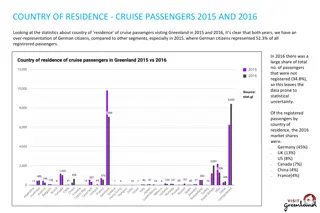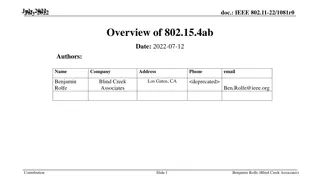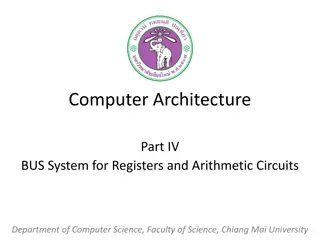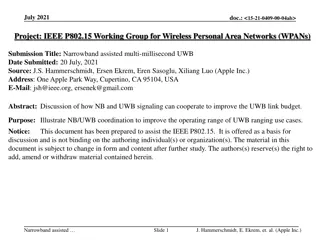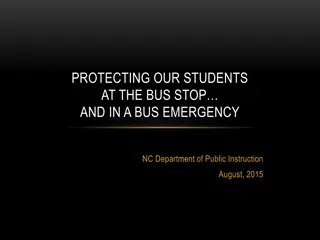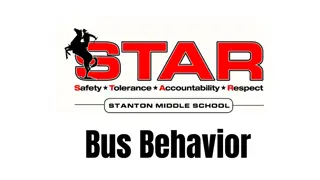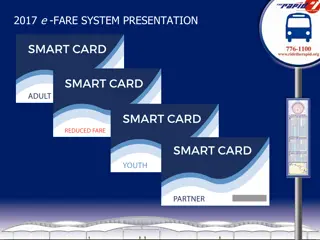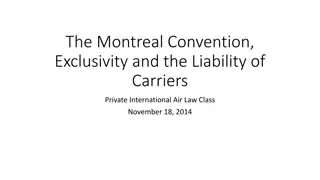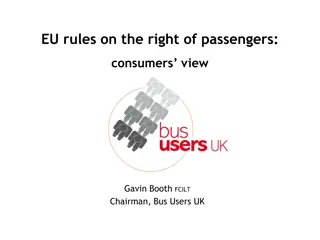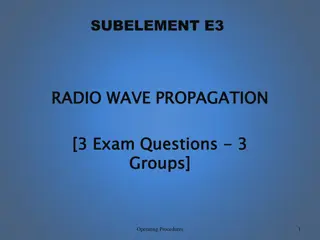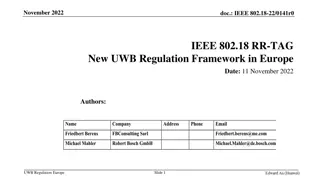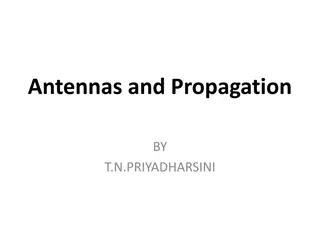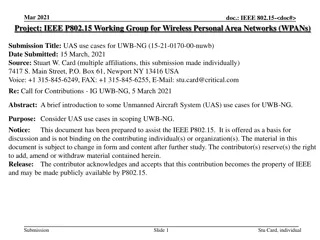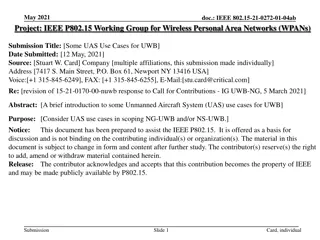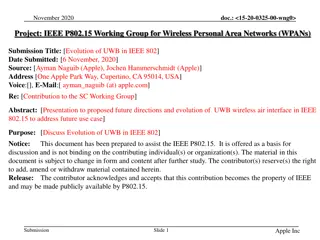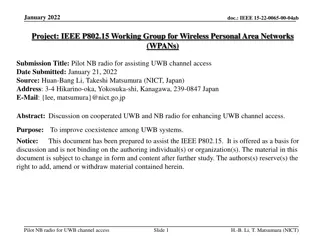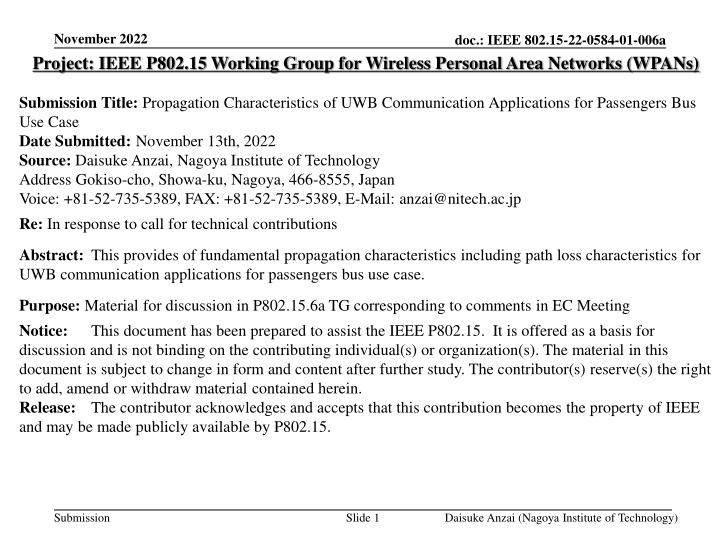
UWB Communication Propagation Characteristics for Passengers Bus Scenario
Explore the propagation characteristics of UWB communication for passengers bus applications, focusing on path loss characteristics. The study delves into fundamental aspects relevant for IEEE P802.15.6a TG discussions and offers valuable insights for the industry.
Download Presentation

Please find below an Image/Link to download the presentation.
The content on the website is provided AS IS for your information and personal use only. It may not be sold, licensed, or shared on other websites without obtaining consent from the author. If you encounter any issues during the download, it is possible that the publisher has removed the file from their server.
You are allowed to download the files provided on this website for personal or commercial use, subject to the condition that they are used lawfully. All files are the property of their respective owners.
The content on the website is provided AS IS for your information and personal use only. It may not be sold, licensed, or shared on other websites without obtaining consent from the author.
E N D
Presentation Transcript
November 2022 Project: IEEE P802.15 Working Group for Wireless Personal Area Networks (WPANs) doc.: IEEE 802.15-22-0584-01-006a Submission Title: Propagation Characteristics of UWB Communication Applications for Passengers Bus Use Case Date Submitted: November 13th, 2022 Source: Daisuke Anzai, Nagoya Institute of Technology Address Gokiso-cho, Showa-ku, Nagoya, 466-8555, Japan Voice: +81-52-735-5389, FAX: +81-52-735-5389, E-Mail: anzai@nitech.ac.jp Re: In response to call for technical contributions Abstract: This provides of fundamental propagation characteristics including path loss characteristics for UWB communication applications for passengers bus use case. Purpose: Material for discussion in P802.15.6a TG corresponding to comments in EC Meeting Notice: This document has been prepared to assist the IEEE P802.15. It is offered as a basis for discussion and is not binding on the contributing individual(s) or organization(s). The material in this document is subject to change in form and content after further study. The contributor(s) reserve(s) the right to add, amend or withdraw material contained herein. Release: The contributor acknowledges and accepts that this contribution becomes the property of IEEE and may be made publicly available by P802.15. Submission Slide 1 Daisuke Anzai (Nagoya Institute of Technology)
November 2022 doc.: IEEE 802.15-22-0584-01-006a Propagation Characteristics of UWB Communication Applications for Passengers Bus Use Case Daisuke Anzai Nagoya Institute of Technology Submission Slide 2 Daisuke Anzai (Nagoya Institute of Technology)
November 2022 doc.: IEEE 802.15-22-0584-01-006a UWB communication applications Vehicle BAN (VBAN) Human BAN (HBAN) Passengers bus model[1] Brain-computer interface (BCI) model[1] [1]IEEE 802.15-22-0344-02-006a Submission Slide 3 Daisuke Anzai (Nagoya Institute of Technology)
November 2022 doc.: IEEE 802.15-22-0584-01-006a Passenger bus model Passenger bus model[1] [1] IEEE 802.15-22-0344-02-006a Submission Slide 4 Daisuke Anzai (Nagoya Institute of Technology)
November 2022 doc.: IEEE 802.15-22-0584-01-006a Simulation setup Frequency band: 3.1 10.6 GHz Ray-tracing method Cylinder model employed as a human model for simplification HBAN node on the chest of the human model P5 P6 P3 P2 P1 P4 P1 (HBAN-HBAN) P2 (HBAN-HBAN) P3 (VBAN-VBAN) P4 (VBAN-VBAN) P5 (VBAN-VBAN) P6 (VBAN-VBAN) Submission Slide 5 Daisuke Anzai (Nagoya Institute of Technology)
November 2022 doc.: IEEE 802.15-22-0584-01-006a Path loss characteristics (2 passengers) Submission Slide 6 Daisuke Anzai (Nagoya Institute of Technology)
November 2022 doc.: IEEE 802.15-22-0584-01-006a Path loss characteristics (2 passengers) Submission Slide 7 Daisuke Anzai (Nagoya Institute of Technology)
November 2022 doc.: IEEE 802.15-22-0584-01-006a Path loss characteristics (10 passengers) Submission Slide 8 Daisuke Anzai (Nagoya Institute of Technology)
November 2022 doc.: IEEE 802.15-22-0584-01-006a Path loss characteristics (10 passengers) Submission Slide 9 Daisuke Anzai (Nagoya Institute of Technology)
November 2022 doc.: IEEE 802.15-22-0584-01-006a Summary and future works The path loss characteristics were evaluated based on the ray-tracing method under passenger bus environments Future works includes time-domain analyses in the passenger bus model including multipath power delay profile and RMS multipath delay spread Submission Slide 10 Daisuke Anzai (Nagoya Institute of Technology)
November 2022 doc.: IEEE 802.15-22-0584-01-006a References 1. D. Anzai, I. Balasingham, G. Fischer, J. Wang, Reliable and High-Speed Implant Ultra-Wideband Communications Diversity, EAI/Springer Innovations in Communication and Computing, pp. 27-32, March 2020. Y. Shimizu, D. Anzai, R. C-Santiago, P. A. Floor, I. Balasingham, and J. Wang, Performance evaluation of an ultra-wideband transmit diversity in a living animal experiment IEEE Trans. Microw. Theory Tech., vol. 65, no. 7, pp. 2596-2606, July 2017. D. Anzai, K. Katsu, R. Chavez-Santiago, Q. Wang, D. Plettemeier, J. Wang, and I. Balasingham, Experimental evaluation of implant UWB-IR transmission with living animal for body area networks, IEEE Trans. Microw. Theory Tech., vol. 62, no. 1, pp. 183-192, Jan. 2014. J. Shi, D. Anzai, and J. Wang, Channel modeling and performance analysis of diversity reception for implant UWB wireless link, IEICE Trans. Commun., no. E95-B, vol. 10, pp. 3197-3205, Oct. 2012. with Transmit Receive 2. 3. 4. Submission Slide 11 Daisuke Anzai (Nagoya Institute of Technology)


